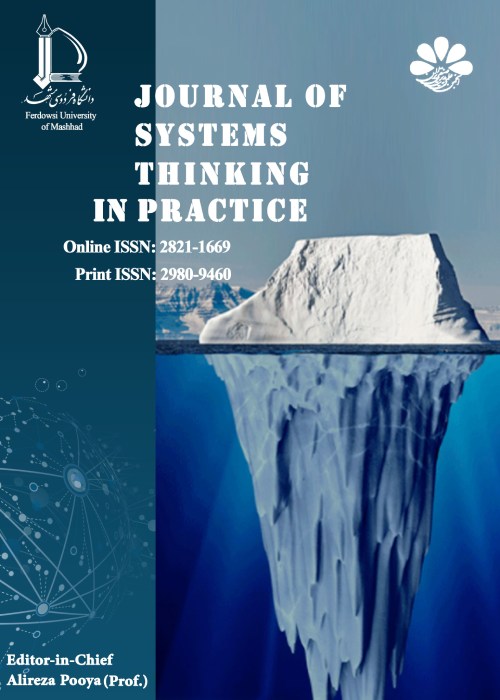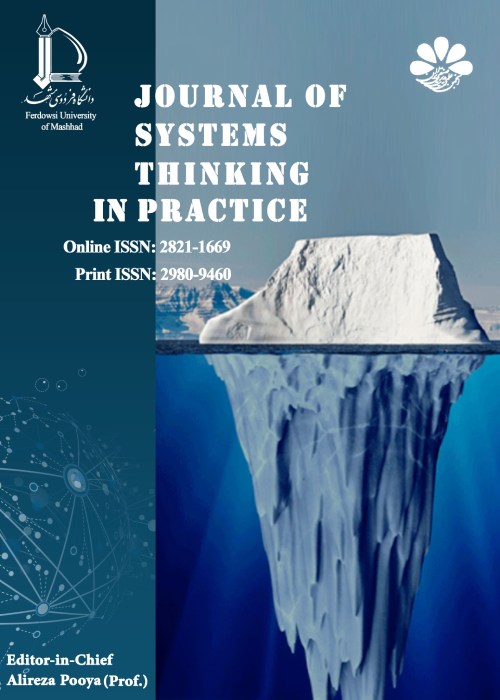فهرست مطالب

Journal of Systems Thinking in Practice
Volume:2 Issue: 4, Dec 2023
- تاریخ انتشار: 1402/09/10
- تعداد عناوین: 6
-
-
Pages 1-16
The supply chain includes all the activities required to deliver a product or service to end customers. By adopting the above approach to the supply chain, production and distribution functions are added to the chain as part of the flow of goods and services. The supply chain in this approach includes three areas: procurement, production, and distribution. This article results from a research project commissioned by the Kermanshah Industry, Mining, and Trade Organization to improve the production capacity of metal industries in the province. Based on this, effective loops were identified with the initial introduction of 26 selected companies active in the province and conducting several rounds of interviews with the management and experts of these companies. With the suggestion of the Industry, Mining, and Trade Organization and with the agreement and participation of the best and most complete company active in this context (Shablon Tajhiz), it was modeled and executed. The formulation was designed with the participation of the panel of experts and in the form of discussion sessions based on the trial and error method. In order to confirm the results, the statistical data of the company was extracted from 1390 and compared and validated with the results obtained from the model's output. Since the nature of these loops and their constituent variables change over time in the actual state. A dynamic systems approach has been used to simulate the model and consider dynamic conditions and their mutual effects. The structure of the results was checked and confirmed through the sensitivity analysis of the findings. It is worth mentioning that the analysis and drawing of the results were done using Vensim software.
Keywords: model design, production chain simulation, metal industries, System dynamics, missing loops -
Pages 17-32
Nowadays, countries are leading in growth and development, with their managers having a systematic approach and perspective toward external phenomena. In the past, the slow pace of changes and transformations in societies made it easier to analyze current and future conditions. However, in today's world, complex phenomena are non-linear and multidimensional. The migration of skilled and educated human resources from developing to developed countries is also considered one of these phenomena, which is influenced by numerous variables and factors that change and evolve over different periods. The system dynamics approach is a precise modeling method that allows us to simulate complex and dynamic systems computationally, both qualitatively and quantitatively. By utilizing the obtained results, more effective policies and organizations can be designed. This paper discusses the migration of elites from Iran to developed countries from a dynamic systems perspective. The problem is modeled and simulated using the software "Vensim". Important variables in elite migration are identified and adjusted. The model's outputs indicate the positive impact of the presence of elites in a country on its level of economic development.
Keywords: Elite migration, System dynamics, Socio-economic variables, computer simulation, Scenario analysis -
Pages 33-56
In recent years, there has been a growing interest in Systems Thinking (ST) as a significant area of research. It has become increasingly crucial to provide a detailed overview of the ST domain and to identify the prevailing research focuses and trends within this realm. This study represents the most comprehensive and pioneering effort, using topic modeling analysis to analyze the landscape of ST research from the past to the present. The primary objective of this study was to identify the current state of research and the predominant areas of focus within articles related to ST. To achieve this research aim, a search was conducted on August 20, 2023, using the Scopus database, yielding 1400 articles. The bibliometric analysis findings of this study indicate a substantial surge in the number of publications in this field, especially since 2016, with a significant majority of these studies originating from the United States. While the research is characterized by its interdisciplinary nature, most publications fall within social science. Employing Latent Dirichlet Allocation (LDA), Non-Negative Matrix Factorization (NMF), and Bidirectional Encoder Representations (BER) Topic algorithms for topic modeling analysis, the study classified the articles into ten distinct topics. These topics encompass "comprehending and modeling complex systems," "sustainability in business," "interdisciplinary learning and problem-solving in education," "enhancing healthcare delivery," "system dynamics modeling," "engineering education," "chemistry education," "enhancing patient outcomes," "environmental sustainability," and "improving organizational performance." The most prominent topics that represent common research areas in the field of Systems Thinking include "system dynamics modeling," "enhancing healthcare delivery," "interdisciplinary learning and problem-solving in education," "comprehending and modeling complex systems," "environmental sustainability," and "improving organizational performance". In conclusion, this study is expected to provide valuable guidance for future research in the field of Systems Thinking by aiding in identifying research interests and trends.
Keywords: System Thinking, Topic Modeling, BER Topic, Latent Dirichlet Allocation, Non-Negative Matrix Factorization -
Pages 57-77Smart manufacturing can be referred to as an important consequence of the Fourth Industrial Revolution. With the advent of this revolution, manufacturing companies must use numerous new technologies to become smart. Companies face multifaceted challenges because of these new technologies. The Internet of Things (IoT) technology is one of the achievements of Industry 4.0, which plays an important role in implementing smart manufacturing. IoT used in smart manufacturing is called the Internet of Manufacturing Things (IoMT Like other technologies, IoMT has its challenges. Therefore, manufacturing organizations must be able to identify these challenges and concentrate on them based on their priority. This study identified the challenges of using the Internet of Things in smart manufacturing were identified by reviewing the literature. The Interpretive Structural Modeling (ISM) technique was used to prioritize challenges in the automotive industry. Based on the research findings, the challenges were classified into three levels. This leveling provides a suitable model for automotive industry managers prioritize their strategies and actions accordingly.Keywords: Smart manufacturing, Internet of Things, Internet of Manufacturing Things, challenges, interpretive structural modeling
-
Pages 78-104One of the main obstacles to the adoption of blockchain is the cost of its adoption. The application of this technology in an organization requires the costs of development, design, maintenance, hardware, software, and energy consumption according to its adoption rate. This study uses system dynamics (SD) and machine learning (ML) methods to predict the final cost of blockchain implementation. Compared to mathematical programming, simulation techniques for estimating costs are scarce. However, SD modeling is suitable to account for the complexity and dynamic of systems and support long-term, strategic decision-making. To better understand the system behavior, it is necessary to formulate the relationships between the variables and simulate the values of the variables over time. The relationship between these variables is analyzed using the qualitative SD modeling method with stakeholders through questionnaires and 15 interviews. After identifying the variables, their effect on each other and the implementation cost are investigated. Since the charts obtained from the SD give us the behavior of state and flow variables for time, linear regression applying cross-validation, as one of the ML methods, is used to get a graph showing the system's state as a rate function. Thus, this research provides a reasonable basis for estimating the cost function of blockchain implementation. The validity of the suggested method's results is investigated through sensitivity analysis. The results demonstrate the effectiveness of the proposed model. Simulation results indicate that implementing scenarios such as changes in the average block creation time significantly enhances transaction cost, hardware cost, and software cost, leading to increased implementation cost of blockchain for organizations. The results of this research can significantly help decision-makers develop and apply blockchain technology in organizations.Keywords: System dynamics, Blockchain, Cost management, transaction
-
Pages 105-131
Implementing the human resources ecosystem poses a significant challenge for large private and public organizations. This challenge is exacerbated by the comprehensive nature of its concepts and its dependence on the availability of rich and abundant resources. The primary objective of this research is to scrutinize the barriers hindering the implementation of the human resources ecosystem in Iran, considering the prevailing environmental conditions. The secondary goal is to propose viable steps for resolving these problems and overcoming the barriers through a comprehensive understanding of the challenges associated with implementing this ecosystem. The Total Systems Intervention (TSI) meta-methodology system was selected to achieve a holistic understanding of the system. Deploying the Total Systems Intervention framework, a systematic process was initiated to identify the system's principal challenges and pinpoint applicable methods. Nine main challenges were identified, leading to the selection of two methods—namely, the Importance-Performance Approach (IPA) and the Soft Systems Methodology (SSM)—for categorization and the development of implementation solutions. The findings, based on the perspectives of seven experts in the field of human resources, revealed that non-compliance with strategic plans with the human resource ecosystem and environmental dynamism and uncertainty are the most crucial and impactful barriers. Consequently, issues such as the lack of executive flexibility and insufficient stakeholder participation were identified as additional problems of high importance but lower effectiveness. Subsequently, the research delved into discussing methods for implementing and monitoring the ecosystem, resulting in the design of a comprehensive framework for implementation. The research underscores that successfully implementing the human resources ecosystem necessitates internal system integration and alignment among managers, stakeholders, programs, and resources. This alignment accelerates and streamlines the implementation process, highlighting the importance of a cohesive approach to realizing the system's potential.
Keywords: Human resources ecosystem, Problem Solving, Systems thinking, Soft systems methodology, Total systems interventions


